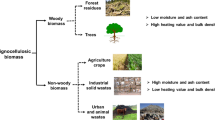Abstract
Biomass can be converted into flammable gas, charcoal, wood vinegar, wood tar oil and noncombustible materials with thermo-chemical pyrolysis reactions. Many factors influence these processes, such as the properties of the raw materials, and temperature control and these will affect the products that are produced. Based on the data from a straw pyrolysis demonstration project, the mass and heat balance of the biomass pyrolysis process were analyzed. The statistical product and service solutions (SPSS) statistical method was used to analyze the data which were monitored on-site. A cost-benefit analysis was then used to study the viability of commercializing the project. The analysis included net present value, internal rate of return and investment payback period. These results showed that the straw pyrolysis project has little risk, and will produce remarkable economic benefits.
Similar content being viewed by others
References
Boukis I, Vassilakos N, Kontopoulos G, Karellas S. Policy plan for the use of biomass and biofuels in Greece. Part I: Available biomass and methodology. Renewable & Sustainable Energy Reviews, 2009, 13(5): 971–985
Brune D E, Lundquist T J, Benemann J R. Microalgal biomass for greenhouse gas reductions: potential for replacement of fossil fuels and animal feeds. Journal of Environmental Engineering, 2009, 135(11): 1136–1144
Rentizela A A, Tolis A J, Tatsiopoulos I P. Logistics issues of biomass: the storage problem and the multi-biomass supply chain. Renewable & Sustainable Energy Reviews, 2009, 13(4): 887–894
Wei Q Y, Wang K J, Song Y H, Xu D L. Construction and management mode of biomass centralized gas supply engineering in rural China. Transactions of the Chinese Society of Agricultural Engineering, 2009, 25(5): 303–307 (in Chinese)
Song Y H, Li J R, Wei Q Y. Discussion on energy utilization mode for agriculture wastes in Beijing suburb. Journal of Beijing Electronic Science and Technology Institute, 2006, 14(3): 21–24 (in Chinese)
Hamelinck C, Van H, Faaij A. Ethanol from lignocellulosic biomass: techno-economic performance in short-, middle- and long-term. Biomass and Bioenergy, 2005, 28(4): 384–410
Berggren M, Ljunggren E, Johnsson F. Biomass co-firing potentials for electricity generation in Poland-matching supply and co-firing opportunities. Biomass and Bioenergy, 2008, 32(9): 865–879
Wei Q Y, Qu Y S, Wei X M. Materiel balance calculation for biomass gasification (pyrolysis) process. Renewable Energy Resources, 2009, 27(2): 88–90 (in Chinese)
Chen B M, Chen A N, Zhang Z F. Analysis on the driving and constraint factors of crop straw gasification and commercialization development. Journal of Natural Resources, 2007, 22(1): 62–68 (in Chinese)
Chopey N P. Chemical Engineering Calculation Manual. Dalian: Dalian Institute of Press, 1986, 22–31 (in Chinese)
Wang Z L, Zhou Y P. Physical and Chemical. Beijng: Higher Education Press, 2003, 45–62 (in Chinese)
Zhu W T. Physical and Chemical. Beijing: Tsinghua University Press, 1995, 89–102 (in Chinese)
Chen M H. The Principles of Chemical Engineering. Beijing: Chemical Industry Press, 2006, 69–72 (in Chinese)
Tan T, Dou M, Zhou M H. The Principles of Chemical Engineering. Beijing: Chemical Industry Press, 2006, 42–56 (in Chinese)
Chen Y M, Tsao T H. A structured methodology for implementing engineering data management. Robotics and Computer-integrated Manufacturing, 1998, 14(4): 275–296
Hu Y. Economic Evaluation Method of Capital Project on Sustainable Development. Guangzhou: Publishing House STAN-KIN, 2000, 498–501 (in Chinese)
Du Z Y. General Method of Statistical Analysis-Spss Application. Jinan: Shandong University Press, 2006, 22–46 (in Chinese)
Chen X Y. Financial Accounting. Beijing: Higher Education Press, 2000, 34–42 (in Chinese)
The Ministry of Finance of PRC. Enterprise Accounting System. Beijing: Economic Science Press, 200, 18–23
Ju E. Financial Accounting. Shanghai: Lixin Kuaiji Press, 2005, 89–97 (in Chinese)
Lyn M F, Aileen O. Understanding Financial Statements. Beijing: Peking University Press, 2006, 66–74
Li Z H, Yi W M, Liu H W. Heat balance analysis of ceramic ball heat carrier and biomass powder. Transactions of the Chinese Society for Agricultural Machinery, 2009, 40(7): 103–106 (in Chinese)
Author information
Authors and Affiliations
Corresponding author
Rights and permissions
About this article
Cite this article
Wei, Q., Qu, Y. & Tan, T. Mass and heat balance calculations and economic evaluation of an innovative biomass pyrolysis project. Front. Chem. Sci. Eng. 5, 355–361 (2011). https://doi.org/10.1007/s11705-010-0567-9
Received:
Accepted:
Published:
Issue Date:
DOI: https://doi.org/10.1007/s11705-010-0567-9




